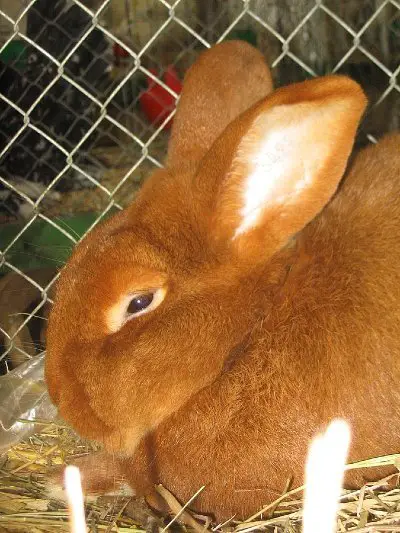Last Updated on June 12, 2023 by Leonard Harper
It was at the begging of the last century when the New Zealand Red rabbit quickly become very popular for its meat. Years later, New Zealand White rabbit was created, not originally bred to be a domestic pet but preferred for its white fur. With a name like ‘New Zealand rabbit‘ you would have thought that this cute little bunny comes from New Zealand, wouldn’t you?
Well, nope! Let’s read on to find out all you need to know about the New Zealand rabbit.
Contents
The Origin of the New Zealand Bunny
The thing is no one actually knows where the New Zealand rabbit came from. We do not know the original breeder or breeders.
What we do know, however, is that the rabbit came to be somewhere in California, to be used for its meat (New Zealand Red Rabbit), later for its fur (New Zealand White Rabbit).
We also know that it was bred from rabbits that were likely imported from New Zealand, although we are not 100% sure what these rabbits are. Many people believe there to be a Flemish Giant and Belgian Hare somewhere in the mix.

It was 1916, when the New Zealand Red rabbit was added to the US rabbit standards by ARBA. An year later in 1917, a New Zealand white rabbit came (these animals were originally red to begin with), and this set the rabbit up nicely for the fur industry.
The Purpose of New Zealand White and Red Rabbit
While the New Zealand Red rabbit is mostly kept as a pet nowadays, when it was first developed back in the early 1900s, there was no intention for it to ever be a pet. Originally, the rabbit was sold mostly for meat and maybe a little bit of fur.
This is because it matured incredibly quickly, and the pelt was nicely textured.
However, when the white New Zealand rabbit came to be, it moved over to the fur industry. This is because the New Zealand white rabbit furs are fantastic for selling. This is because they are easier to dye.
In addition to this, the rabbit is used in laboratory testing. In fact, it is one of the most popular rabbits in labs at the moment, partly because there are very few (actually none) health issues associated with the New Zealands.
The Look of the Rabbit
This is a commercial bodied rabbit. It is fairly chunky in all the right places. This is due to the fact it was originally bred for the meat industry and, of course, there you are going to want to have a fair amount of meat on your rabbit.
Males weigh 9–11 lb (4.1–5.0 kg), while the female rabbits are a couple of pounds heavier than the males, capping out at 12lbs (although, probably veering closer to 10).
The coat is nice and short and very well-groomed. The coat can come in one of five different colors. We should probably point out at this point that each of the colors designates a different subset of the breed.
So, if you were at an ARBA show, a New Zealand red rabbit wouldn’t be competing against a New Zealand white rabbit.
New Zealand Rabbit Colors
These are the colors:
- Broken (a mixture of any other color the rabbit can be, with a bit of white)
- Red
- Black
- Blue
- White
If your rabbit does not have one of those colors, then it is not a real New Zealand rabbit.

The Black New Zealand rabbit first occurred around 1924. This variety was recognized by the ARBA in 1958.
As of 2016, the Blue New Zealand Rabbit is the newest recognized variety of New Zealands in the USA, and now is being shown.
New Zealand Rabbit Lifespan
You can expect a lifespan of a New Zealand rabbit to be somewhere between 5 and 8 years (as a pet). This is surprisingly long-lived for a larger breed of rabbit like this.
Part of the reason as to why this breed is able to live for so long is due to the fact that they do not really have any underlying health issues.
Very few rabbit breeds like this do. So, as long as you keep them fed with a well-balanced diet (and by that, we mean that most of their diet is going to be hay), plus lookout just in case any smaller health issues appear, then we think that this is going to be a rabbit that will live somewhere near the up of the lifespan expectancy for the rabbit.
So, your pet is going to be sticking around for a very, very long time!
The Personality of the Rabbit
Remember what we said earlier? That the rabbit was used in laboratory testing? Well, this isn’t just because they are easy to get hold of. It is because of their personality.
We are not exaggerating when we say that this animal is incredibly calm and docile.
It has an inquisitive nature, but more often than not, it is just going to sit back and relax.

We have rarely seen a New Zealand rabbit (white, red, blue or black) get aggressive under pressure. It keeps quite a level head although, to be honest, this is going to be similar to most other rabbit breeds out there.
This is one of the rabbits we would suggest to just about everybody.
Families will love it. Older people will love it. People who live alone will love it. The New Zealand bunny is able to fit into just about every situation with ease.
Do bear in mind that this is a breed that does love a bit of social contact. While you could keep the rabbit outdoors, it is not something that we suggest. It needs to be interacting with you every single day if you want it to thrive.
Ideally, you would also own a couple of rabbits at once. This will ensure that you are able to really play into the social nature of the New Zealand breed. If you are keeping them outdoors where interaction with you may be a bit more on the limited side, then you will 100+% want another rabbit in there.
It will prevent various issues due to lack of socialness (remember: rabbits are incredibly sociable animals. They need it!)
We want to point out that it is very easy to think that the white New Zealand rabbit is actually a Japanese White rabbit, which is mostly a laboratory bunny in Japan.
Care Requirements
In terms of care requirements, there isn’t really anything special that you need to lookout for with the breed. They may have a gorgeous coat, but it is barely going to need to be brushed. As we said; it can live indoors or outdoors, but the former is preferable.
This is a larger rabbit, and they really do not want to be cooped up outdoors all day. They want somewhere that they can roam around safely, and we feel that the best option for them here is to live inside your home.
Take a look at the best indoor and outdoor rabbit hutches we have carefully chosen for you.
Leo, a novice urban farmer and avid writer hailing from Chicago, Illinois, finds his joy and inspiration in the company of rabbits. His affection for these cuddly creatures started when he was gifted a Mini Rex, named Poe, on his 18th birthday. Poe soon became a source of comfort, companionship, and surprisingly, creative inspiration. He soon expanded his brood to include three more rabbits of different breeds, each with their own engaging tale.
